
Soft Power: The Deeply Personal Painting of Sofia Stevi
Words by Kiriakos Spirou
Location
Soft Power: The Deeply Personal Painting of Sofia Stevi
Words by Kiriakos Spirou
In the work of young Greek artist Sofia Stevi, the sensual and the oneiric mingle in a personal and deeply mysterious way. Originally trained as a graphic designer both in Athens and London, Sofia Stevi has deployed different media to realise her artistic ideas over the years, including bookbinding, painting and writing. Apart from being a creator, she also enjoys facilitating and promoting the work of others, as her experience in publishing and curating reveals: Sofia has co-founded a poetry press in London, and is currently running a project space in Athens called Fokidos. Her intensely emotional use of colour, intuitiveness in drawing and overall softness in both material and form make Sofia Stevi’s work irresistibly attractive and relatable, even when it deals with deep psychological issues such as repressed desire, social oppression and the female experience in a patriarchal society. In the aftermath of a very busy season for her, we had the opportunity to ask the artist a few questions and find out why she loves pink so much, and what she’s up to next.

Sofia Stevi, Lizzie & laura, 2017. Ink, acrylic, gouache on cotton 200x140 cm. Courtesy The Breeder.
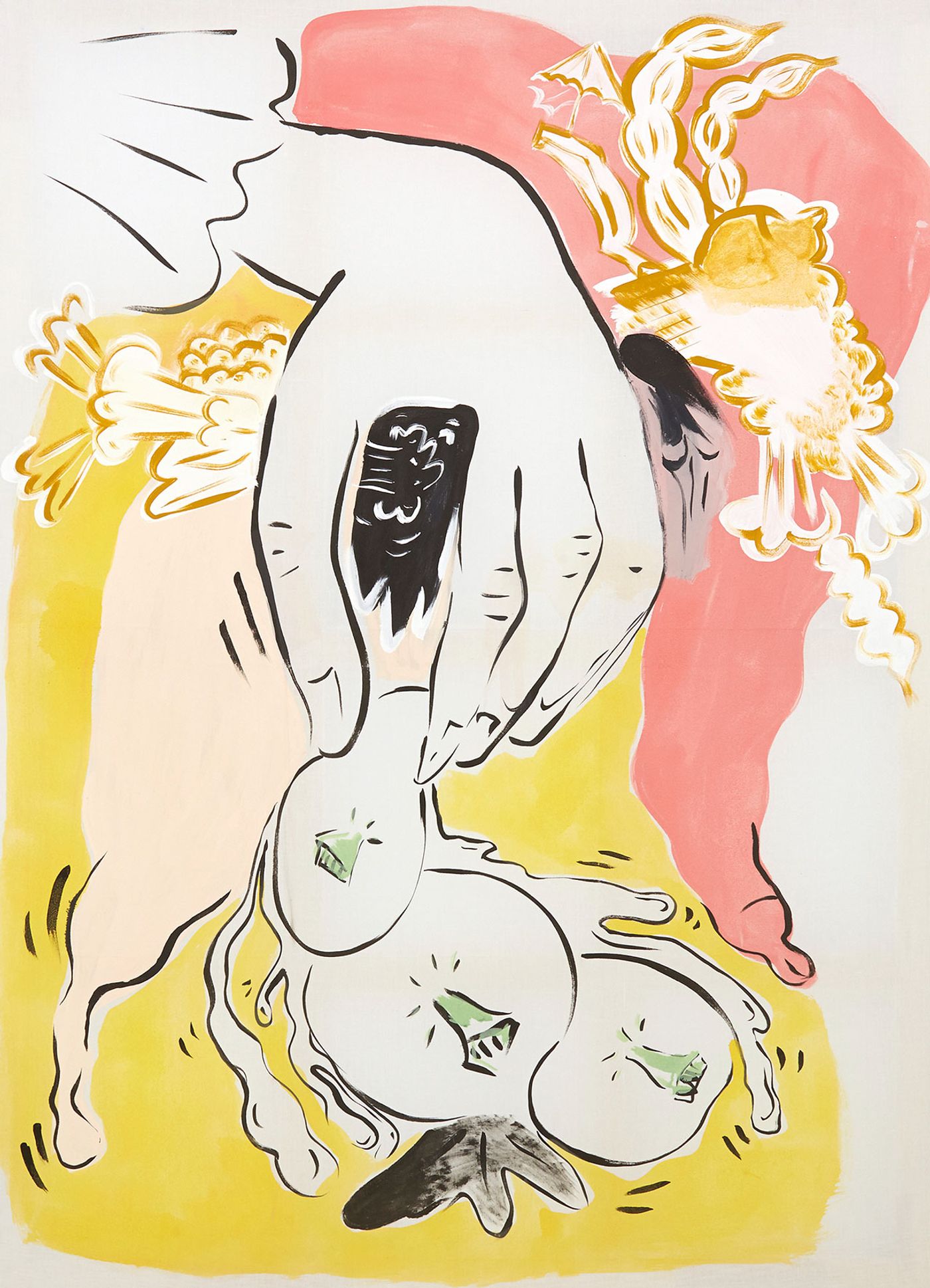
Sofia Stevi, Just like Honey, 2016. Ink, acrylic, gouache on cotton, 200x140 cm. Courtesy The Breeder.
Tell us about how you began drawing and what other creative things you do.
I started painting as a child although I was more interested in literature. Later on I studied graphic design at the Vakalo School in Athens. We weren’t allowed to use computers before the last year of our studies, so we did everything by hand. We were taught colours and drawing and plastic arts as well as history of art and theory. Later, in London I started a masters course at Central St Martin’s in typography. We also had to do a bookbinding course and I fell in love with the craft. So, I left letters behind and began making my book-sculptures using a new technique that I discovered myself. These are books without images or text but are very tactile. This was also a period when I started hanging out with a lot of artists and received a lot of encouragement. I moved to Peckham and rented my first studio in an old disused factory building which mainly housed artists' studios and African churches. It was so great and so bad at the same time! As Peckham, back then, was supposed to be quite dodgy, the houses were very cheap so a lot of artists, poets and musicians lived there. At the end it was a very protective environment for people like me. It felt like a noisy village with Rye Lane in the middle, the train station and all the African shops and hairdressers, charity shops and Primark. South London is very poor in parts and I feel privileged to have been part of a community there. It made me grow.

Sofia Stevi, Lizzie & Laura, 2017, installation view at The Breeder, Athens. Photo courtesy The Breeder.
In your paintings you often use cotton fabric. What made you choose this surface?
Since I don't come from what one could refer to as a traditional painting background I never learned how to prepare or to stretch a canvas. When I started painting I was too poor or scared to go to an art supply store and start buying stretchers. So I painted on materials that I found: pieces of furniture and other stuff that I would find on the street, sometimes they looked more like sculptures rather than paintings. London has very interesting garbage. When I moved back to Athens I wasn't able to do that anymore, the conditions were different and it took me some time to adjust. During my bookbinding days, I have also made some extended research on paper, and I learned to appreciate the beauty of cotton through that. A few summers ago, while I was in London for a solo show, my good friend there who was hosting me in her beautiful apartment decided to move out and offered that I stay there until the end of her lease. As she was packing, she gave me some clothes that she didn't need any more, including some nice white cotton shirts that didn't really fit me, so I started painting on them with ink. I just wanted to try the material and I really enjoyed it. We set up a small unofficial residency there; you can see some images here. When I came back to Athens I began looking for good cotton fabrics to paint on, and now I use about three or four different qualities. I believe it fits very well with the Japanese ink that is my favourite material to paint with. Also, it has this domestic quality that it is very important for me. A piece of fabric can be a painting but it can also be a scarf, a curtain, a blanket, it is soft to the body. I like the idea that I can make paintings that can be transformed into something else.
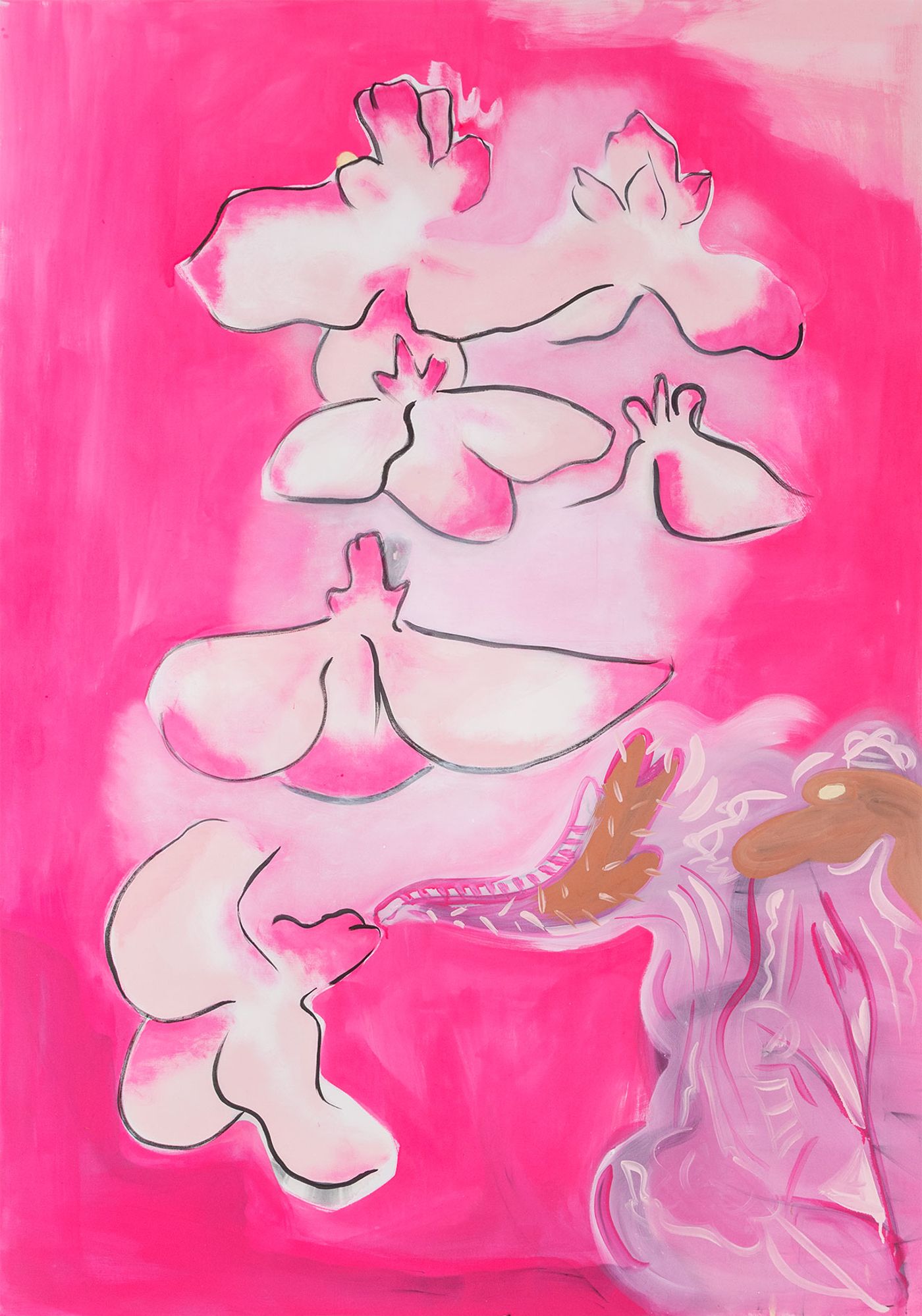
Sofia Stevi, Mary’s pink, 2017. Ink, acrylic, gouache on cotton, 200x140 cm. Courtesy The Breeder.
For your last exhibition at The Breeder gallery in Athens, pink was the most dominant colour, and the same goes for your solo booth at Art Athina last May. What kind of significance does this colour have for you?
Pink is my favourite colour to paint with; I think it just looks really good. It was not an entirely conscious decision to start using it, but I understand that semantically it is very loaded as a colour. Perhaps I am using it so much as a way to neutralise it, as if to say: Pink is the new white.
Would you say that there’s a feminist tone in your works?
My work is about my experience as a human being which happens to identify with being a woman and a feminist. If I make someone think about what it feels like to be a woman through looking at my work, then I’m happy. But my stories are only about my experience, and through my own understanding.
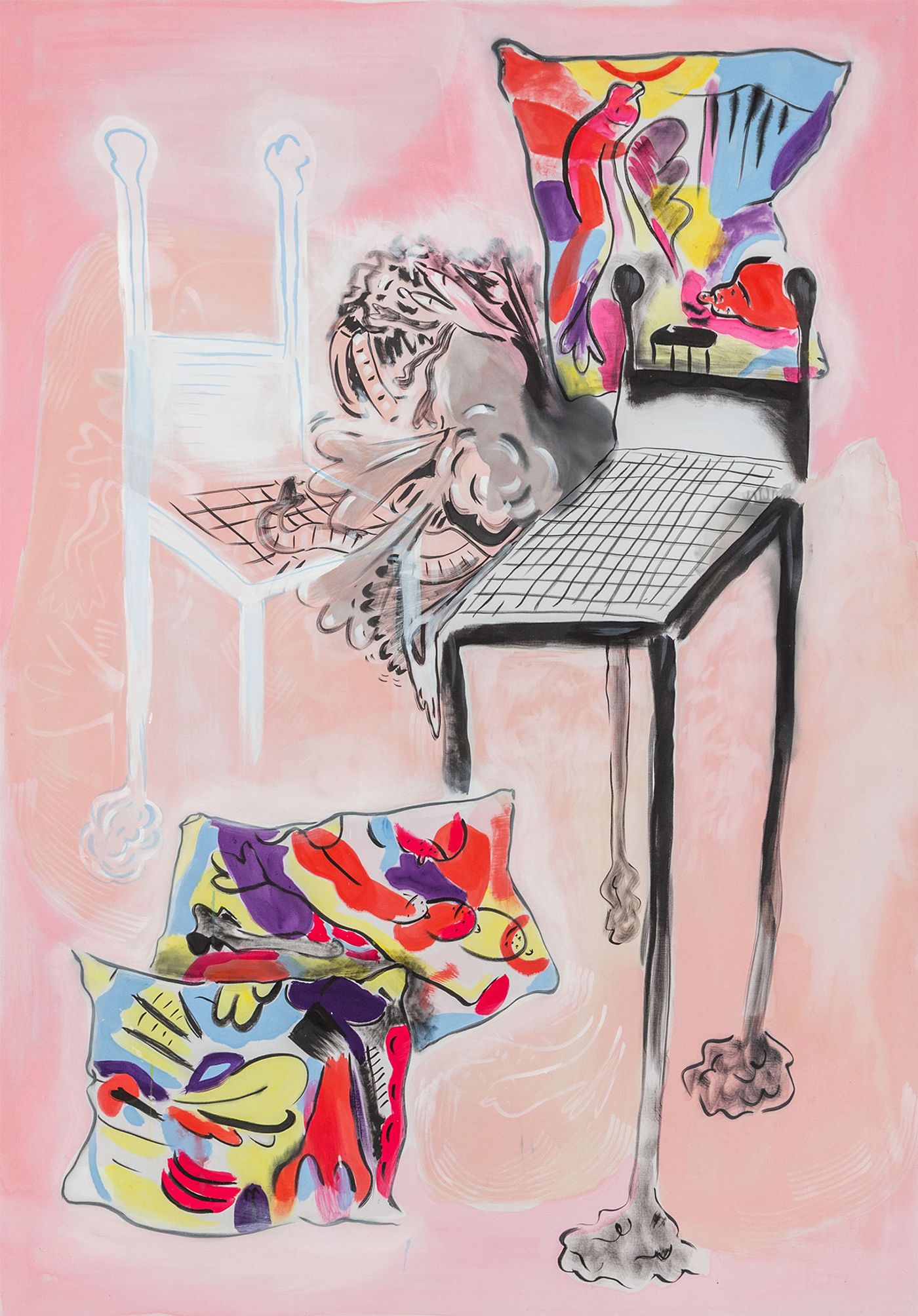
Sofia Stevi, Set for play, 2017. Ink, acrylic, gouache on cotton, 200x140 cm. Courtesy The Breeder.
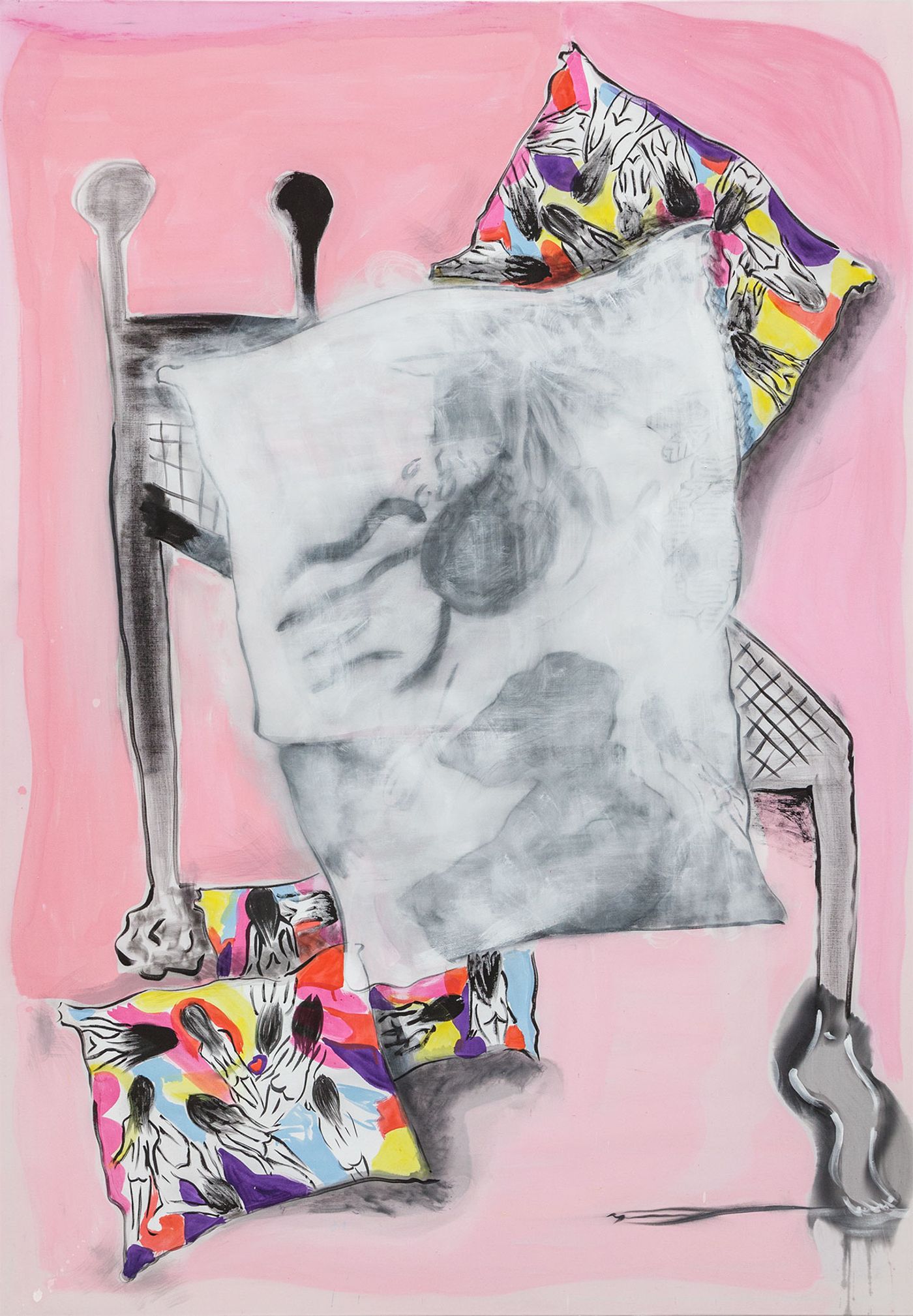
Sofia Stevi, Set for play II, 2017. Ink, acrylic, gouache on cotton, 200x140 cm. Courtesy The Breeder.

Sofia Stevi, Lizzie & Laura, 2017, installation view at The Breeder, Athens. Photo courtesy The Breeder.
When was the Fokidos space founded, and what are its activities?
Fokidos opened in 2013. Our programme is very loose and relies heavily on inspiration, lucky coincidences and our financial situation, since it is all self-funded. Fokidos is basically my apartment's punk alter ego. We have managed to collaborate with a lot of people these four years which I am very grateful for. Fokidos is a space where artists should feel free to do whatever they want (just don't knock my walls down!). I am very glad to say that there is going to be a new collaboration this year with another Greek project that I appreciate a lot but more about it later. As an artist, it is very important to give back to your community and Fokidos is perhaps part of my contribution.

Sofia Stevi, About Everything, 2016. Ink, acrylic, gouache on cotton, 200x140 cm. Courtesy The Breeder.

Sofia Stevi, Lizzie & Laura, 2017, installation view at The Breeder, Athens. Photo courtesy The Breeder.
In your resume we read that you also write texts. What form do these take and how do they relate to your visual work?
I like writing letters and prose. I am not very confident about my writing but I enjoy doing it even if only very few are able to read and experience it. I appreciate writers and poets a lot, and I enjoy collaborating with them; a lot of Fokidos' projects are connected with the written form and I was the co-founder of the Friary Road House poetry press. Sometimes I like writing texts for my exhibitions, not so much as an explanation of the work but more as separate pieces in themselves. For my solo show with The Breeder gallery earlier this year, I decided to ask the writer and poet Dimitra Ioannou to write something which I’m so happy that she agreed to."Turn me into a country tonight" was printed as part of an edition I made for the show at The Breeder but you can also read the poem here.
What else are you working on these days?
I have spent most of these hot summer nights drawing and reading and talking. Now I'm getting ready for some time away in nature, to clear my mind. I will spend August in my studio though, working towards my biggest project yet opening in December, and also some other interesting stuff. I understand that I sound like a mystic when I say this, but the work will come out as clear as spring water.
Sofia Stevi is represented by The Breeder Gallery - Athens and Alma Zevi Gallery - Venice.
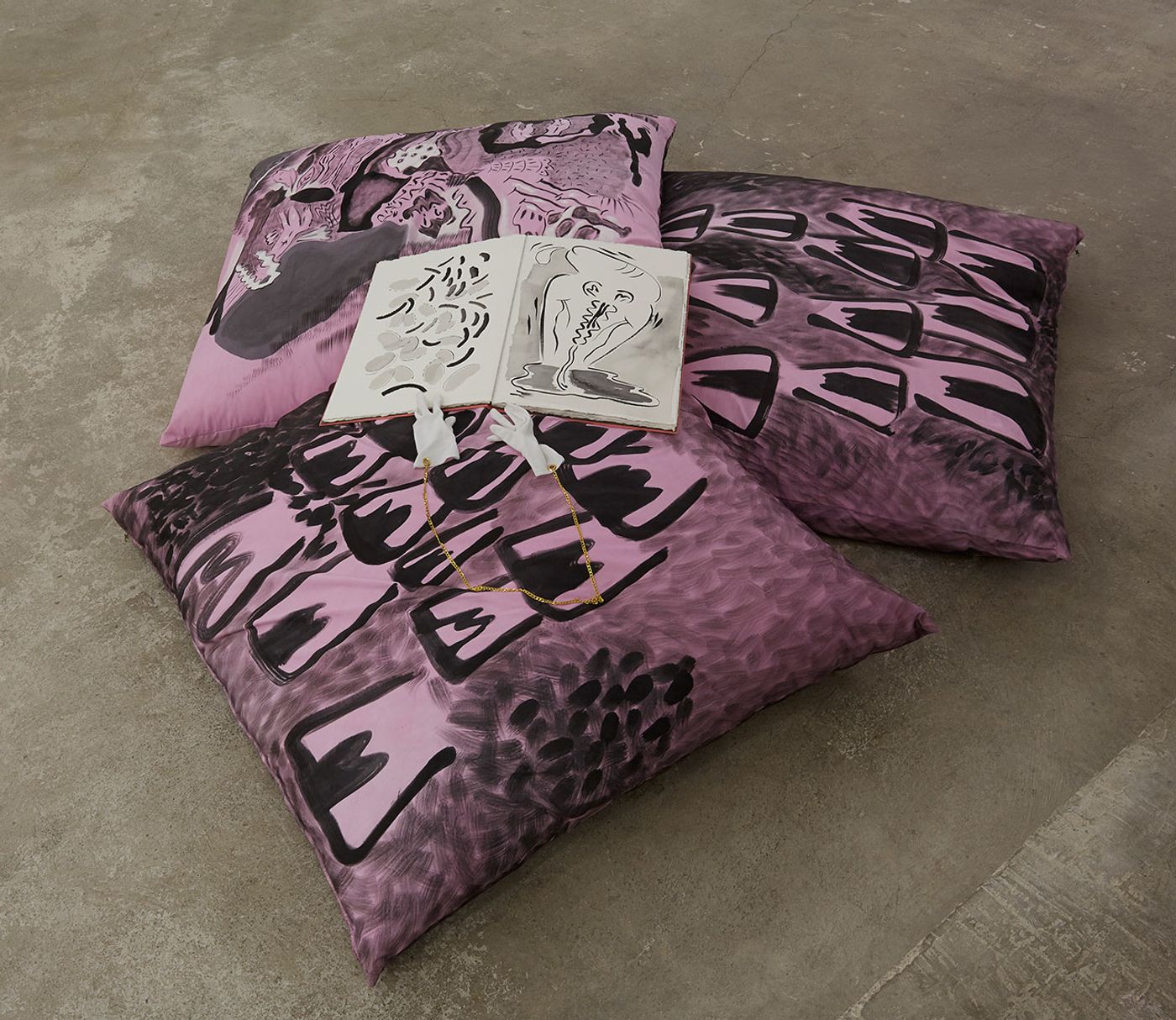
Sofia Stevi, Book A / Pillows, 2016-2017. Ink on mould-made paper, ink and fabric dye on cotton, stuffing, dimensions variable. Courtesy The Breeder.

Sofia Stevi, lizzie & laura, 2017, installation view at The Breeder, Athens. Photo courtesy The Breeder.

Sofia Stevi, Lizzie & Laura, 2017, installation view at The Breeder, Athens. Photo courtesy The Breeder.
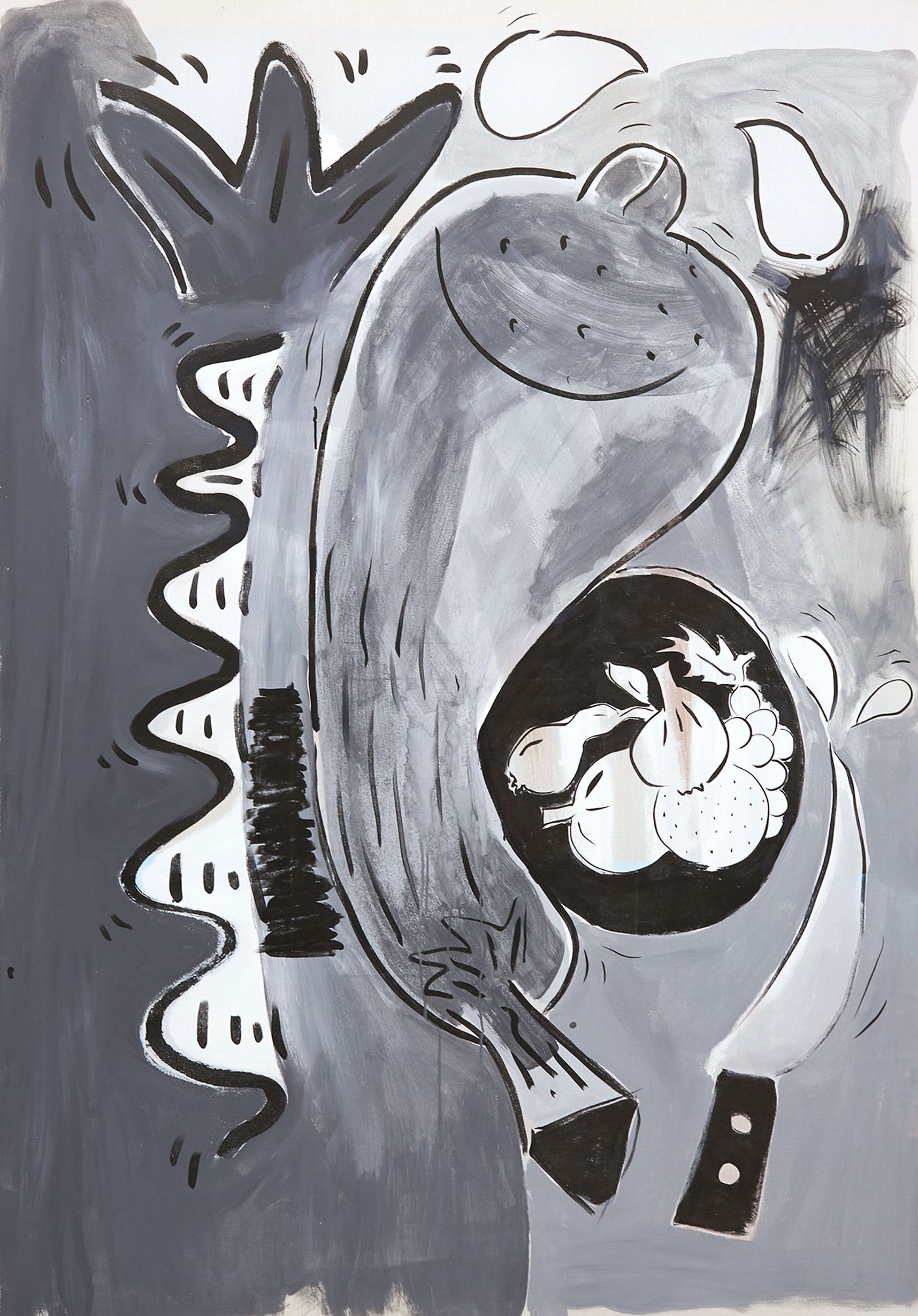
Sofia Stevi, Dinner in Vienna I, 2016. Ink, acrylic, gouache on cotton, 200x140 cm. Courtesy The Breeder.

Sofia Stevi, Lizzie & Laura, 2017, installation view at The Breeder, Athens. Photo courtesy The Breeder.